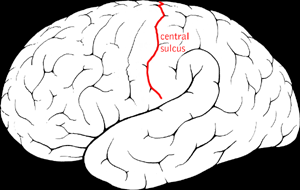Related Research Articles

In human biology, handedness is an individual's preferential use of one hand, known as the dominant hand, due to it being stronger, faster or more dextrous. The other hand, comparatively often the weaker, less dextrous or simply less subjectively preferred, is called the non-dominant hand. In a study from 1975 on 7,688 children in US grades 1-6, left handers comprised 9.6% of the sample, with 10.5% of male children and 8.7% of female children being left-handed. Overall, around 90% of people are right-handed. Handedness is often defined by one's writing hand, as it is fairly common for people to prefer to do a particular task with a particular hand. There are people with true ambidexterity, but it is rare—most people prefer using one hand for most purposes.

In neuroanatomy, the central sulcus is a sulcus, or groove, in the cerebral cortex in the brains of vertebrates. It is sometimes confused with the longitudinal fissure.
The term laterality refers to the preference most humans show for one side of their body over the other. Examples include left-handedness/right-handedness and left/right-footedness; it may also refer to the primary use of the left or right hemisphere in the brain. It may also apply to animals or plants. The majority of tests have been conducted on humans, specifically to determine the effects on language.

The planum temporale is the cortical area just posterior to the auditory cortex within the Sylvian fissure. It is a triangular region which forms the heart of Wernicke's area, one of the most important functional areas for language. Original studies on this area found that the planum temporale was one of the most asymmetric regions in the brain, with this area being up to ten times larger in the left cerebral hemisphere than the right.
Ocular dominance, sometimes called eye preference or eyedness, is the tendency to prefer visual input from one eye to the other. It is somewhat analogous to the laterality of right- or left-handedness; however, the side of the dominant eye and the dominant hand do not always match. This is because both hemispheres control both eyes, but each one takes charge of a different half of the field of vision, and therefore a different half of both retinas. There is thus no direct analogy between "handedness" and "eyedness" as lateral phenomena.

The Wisconsin Card Sorting Test (WCST) is a neuropsychological test of set-shifting, which is the capability to show flexibility when exposed to changes in reinforcement. The WCST was written by David A. Grant and Esta A. Berg. The Professional Manual for the WCST was written by Robert K. Heaton, Gordon J. Chelune, Jack L. Talley, Gary G. Kay, and Glenn Curtiss.
Doreen Kimura was a Canadian psychologist who was professor at the University of Western Ontario and professor emeritus at Simon Fraser University. Kimura was recognized for her contributions to the field of neuropsychology and later, her advocacy for academic freedom. She was the founding president of the Society for Academic Freedom and Scholarship.

Norman Geschwind was a pioneering American behavioral neurologist, best known for his exploration of behavioral neurology through disconnection models based on lesion analysis.

In human neuroanatomy, brain asymmetry can refer to at least two quite distinct findings:
Auditory agnosia is a form of agnosia that manifests itself primarily in the inability to recognize or differentiate between sounds. It is not a defect of the ear or "hearing", but rather a neurological inability of the brain to process sound meaning. While auditory agnosia impairs the understanding of sounds, other abilities such as reading, writing, and speaking are not hindered. It is caused by bilateral damage to the anterior superior temporal gyrus, which is part of the auditory pathway responsible for sound recognition, the auditory "what" pathway.

Researchers have suggested a link between handedness and ability with mathematics. This link has been proposed by Geschwind, Galaburda, Annett, and Kilshaw. The suggested link is that a brain without extreme bias towards locating language in the left hemisphere would have an advantage in mathematical ability.
Left-handedness always occurs at a lower frequency than right-handedness. Generally, left-handedness is found in 10.6% of the overall population. Some studies have reported that left-handedness is more common in twins than in singletons, occurring in 21% of people who are twins. However other studies did not find a higher left-handedness prevalence in twins compared to singletons.

Yakovlevian torque is the tendency of the right side of the human brain to be warped slightly forward relative to the left and the left side of the human brain to be warped slightly backward relative to the right. This is responsible for certain asymmetries, such as how the lateral sulcus of the human brain is often longer and less curved on the left side of the brain relative to the right. Stated in another way, Yakovlevian torque can be defined by the existence of right-frontal and left-occipital petalias, which are protrusions of the surface of one hemisphere relative to the other. It is named for Paul Ivan Yakovlev (1894–1983), a Russian-American neuroanatomist from Harvard Medical School.
Dichotic listening is a psychological test commonly used to investigate selective attention and the lateralization of brain function within the auditory system. It is used within the fields of cognitive psychology and neuroscience.
Sex differences in cognition are widely studied in the current scientific literature. Biological and genetic differences in combination with environment and culture have resulted in the cognitive differences among males and females. Among biological factors, hormones such as testosterone and estrogen may play some role mediating these differences. Among differences of diverse mental and cognitive abilities, the largest or most well known are those relating to spatial abilities, social cognition and verbal skills and abilities.
Paul Satz was an American psychologist, and one of the founders of the discipline neuropsychology. His research on the relationship between the brain and human behavior spanned diverse topics including laterality, handedness, and developmental disorders. He published over 300 publications, received numerous grants and awards, and established the first neuropsychology lab. Towards the latter part of his career, Satz's research interests focused more on the cognitive deficits associated with head injury, dementia, and ageing.
An estimated 90% of the world's human population consider themselves to be right-handed. The human brain's control of motor function is a mirror image in terms of connectivity; the left hemisphere controls the right hand and vice versa. This theoretically means that the hemisphere contralateral to the dominant hand tends to be more dominant than the ipsilateral hemisphere, however this is not always the case and there are numerous other factors which contribute in complex ways to physical hand preference.
Social cognitive neuroscience is the scientific study of the biological processes underpinning social cognition. Specifically, it uses the tools of neuroscience to study "the mental mechanisms that create, frame, regulate, and respond to our experience of the social world". Social cognitive neuroscience uses the epistemological foundations of cognitive neuroscience, and is closely related to social neuroscience. Social cognitive neuroscience employs human neuroimaging, typically using functional magnetic resonance imaging (fMRI). Human brain stimulation techniques such as transcranial magnetic stimulation and transcranial direct-current stimulation are also used. In nonhuman animals, direct electrophysiological recordings and electrical stimulation of single cells and neuronal populations are utilized for investigating lower-level social cognitive processes.
Developmental neuropsychology combines the fields of neuroscience and developmental psychology, while drawing from various other related disciplines. It examines the relationship of behavior and brain function throughout the course of an individual's lifespan, though often emphasis is put on childhood and adolescence when the majority of brain development occurs. Research tends to focus on development of important behavioral functions like perception, language, and other cognitive processes. Studies in this field are often centered around children or other individuals with developmental disorders or various kinds of brain related trauma or injury. A key concept of this field is that looks at and attempts to relate the psychological aspects of development, such as behavior, comprehension, cognition, etc., to the specific neural structures; it draws parallels between behavior and mechanism in the brain. Research in this field involves various cognitive tasks and tests as well as neuroimaging. Some of the many conditions studied by developmental neuropsychologists include congenital or acquired brain damage, autism spectrum disorder, attention deficit disorder, executive dysfunction, seizures, intellectual disabilities, obsessive compulsive disorder, stuttering, schizophrenia, developmental aphasia, and other learning delays such as dyslexia, dysgraphia, and dyspraxia.

Mike Nicholls is an Australian researcher in experimental psychology.
References
- ↑ Oldfield, RC (March 1971). "The assessment and analysis of handedness: The Edinburgh inventory". Neuropsychologia. 9 (1): 97–113. doi:10.1016/0028-3932(71)90067-4. PMID 5146491.
- ↑ Verdino, M; Dingman, S (April 1998). "Two measures of laterality in handedness: the Edinburgh Handedness Inventory and the Purdue Pegboard test of manual dexterity". Perceptual and Motor Skills. 86 (2): 476–8. doi:10.2466/pms.1998.86.2.476. PMID 9638746. S2CID 40945292.
- ↑ Knecht, S; Dräger, B; Deppe, M; Bobe, L; Lohmann, H; Flöel, A; Ringelstein, E-B; Henningsen, H (December 2000). "Handedness and hemispheric language dominance in healthy humans". Brain. 123 (12): 2512–8. doi:10.1093/brain/123.12.2512. PMID 11099452.
- ↑ Wolman, David (2006). A left-handed Turn Around the World. Da Capo Press. ISBN 978-0-306-81498-3.
- ↑ Williams, Stephen M. (1991-01-01). "Handedness inventories: Edinburgh versus Annett". Neuropsychology. 5 (1): 43–48. doi:10.1037/0894-4105.5.1.43. ISSN 1931-1559.
- ↑ Edlin, James M.; Leppanen, Marcus L.; Fain, Robin J.; Hackländer, Ryan P.; Hanaver-Torrez, Shelley D.; Lyle, Keith B. (2015-03-01). "On the use (and misuse?) of the Edinburgh Handedness Inventory". Brain and Cognition. 94: 44–51. doi:10.1016/j.bandc.2015.01.003. ISSN 0278-2626.
- ↑ Fazio, Rachel; Dunham, Kathryn J.; Griswold, Shannon; Denney, Robert L. (2013-07-01). "An Improved Measure of Handedness: The Fazio Laterality Inventory". Applied Neuropsychology: Adult. 20 (3): 197–202. doi:10.1080/09084282.2012.684115. ISSN 2327-9095.
- ↑ Dragovic, Milan (2004-10-01). "Towards an improved measure of the Edinburgh Handedness Inventory: A one‐factor congeneric measurement model using confirmatory factor analysis". Laterality: Asymmetries of Body, Brain and Cognition. 9 (4): 411–419. doi:10.1080/13576500342000248. ISSN 1357-650X.
- ↑ Williams, Stephen M. (1986-06-01). "Factor Analysis of the Edinburgh Handedness Inventory". Cortex. 22 (2): 325–326. doi: 10.1016/S0010-9452(86)80058-2 . ISSN 0010-9452.
- ↑ Williams, Stephen Meredith (2020). "A major revision of the Edinburgh Handedness Inventory: The EHI-8". ResearchGate. doi:10.13140/RG.2.2.15176.55042/1.